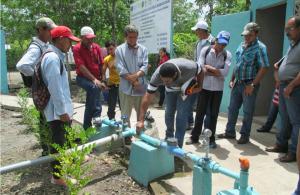by Heyddy Calderon (ELP 2016) | Head of Research and Development, Nicaraguan Aquatic Resources Research Center (CIRA), Nicaragua
James Carville, campaign strategist for Bill Clinton in 1992, used a similar expression to refer to the relevance of the economy at that moment. I’d like to borrow Carville’s phrase and extrapolate it to a broader context to call your attention on something even more important and let me use a curious parallelism to explain further.
The state of California is the 5th largest economy in the world with a GSP of around 3 trillion dollars and a geographical area of around 411 000 km2. I come from Nicaragua, a country with a GDP of around 12.7 billion dollars and 3 times smaller in size. Yes, huuuge difference, right?; yet, there is the issue of water. California has suffered from a drought for the last 5 years. The last 3 years were also very dry for Nicaragua, and 2016 was looking apocalyptic with the forecasts of an extraordinary “El Nino”, which would have caused terrible damage to our agriculture and overall economy.
I had the chance to have a little talk with an officer from the Department of Water Resources of California during a reception organized for the 2016 ELP. I took this opportunity to inquire about how this great state manages its water resources. Surprise! They have as many shortcomings as my dear Nicaragua, and amazingly very similar challenges: until 2013, they had no legal framework to manage groundwater, there is a substantial lack of groundwater monitoring, they struggle to establish mechanisms to allocate water rights, enforce the recent groundwater act and around 2000 wells have run dry during this drought. I heard a very similar story from an extension specialist working with farmers in Salinas, an area where extremely profitable farming occurs. But how is it possible? I was, of course, fascinated by the realization of these similarities with Nicaragua’s struggle to manage water. I wanted to know how and why this superb society with its impressive economy still shared the challenges of a small developing country, and how they are facing them. Was there hope?
Despite the drought, Californian farmers had only $2 billion losses, and I say only, because the revenues for this industry are around $ 80 billion per year. Obviously, the amount of wealth California possesses plays a key role on how a drought is mitigated. During normal precipitation periods, water is brought from the wetter region in the northern part of the state to the central region, where they need it for irrigation. They move large volumes of water hundreds of kilometers. During drought, farmers turn to groundwater. Money can buy new or deeper wells and the increment of costs for irrigation due to water pumping is not an issue when you make so much money from strawberries, lettuce and other delicious and pricey vegetables. Unfortunately, not all farmers in Nicaragua can afford such luxuries as pumping groundwater; either due to spatial unavailability of groundwater, or prohibiting drilling and energy costs.
Sprinkler irrigation in Salinas. Source: California Water Department
It seems abundant financial resources is essential, indeed. But is money all it takes? No, of course not, you also need brains and something perhaps more important, political will. Groundwater depletion due to overpumping was already a concern in California, along with associated problems like brackish water and land subsidence. Therefore, a groundwater act was approved in 2013; although it is proving to be difficult to implement, as one could expect with any new regulation. However, the legal instrument is in place and that is a big step. Same applies to Nicaragua, whose water law was approved in 2007, although is still taking baby steps regarding implementation most likely due to a combination of lack of financial resources and a comprehensive strategy for its implementation.
Water sources in California have been diversified: surface water, groundwater, reservoirs, desalinization, without forgetting water use optimization and reuse. This is important, public awareness and visionary or at least cautious leaders, are key in dealing with water threats, be it scarcity or excess. Unfortunately, this awareness seems to be inversely correlated to the amount of water available to provide for our needs. We, Nicaraguans, also tend to forget how important water is, the minute it magically appears when we open the tap. Then, perhaps as Californians do, we also need continuous reminders and education to install a different water culture.
There is one more thing, which is probably the most difficult, and yet the most essential: collaborative management efforts, across agencies and at all levels, from the community to the state government. A large part of this management is done by local organizations in California and in rural Nicaragua, drinking water is managed mostly by local entities called Drinking Water Committees (CAPS). Collaborative efforts are numerous among CAPS, universities and national and international agencies, but there is definitely much more to do.
Water committee in a rural community of Nicaragua. Source: inventariandocr.com
The similarities (and disparities) I have seen between California and Nicaragua regarding water management is up to a certain point, encouraging; perhaps we are both taking some steps in the right direction, but we both definitely have a long way ahead of us.


